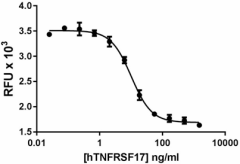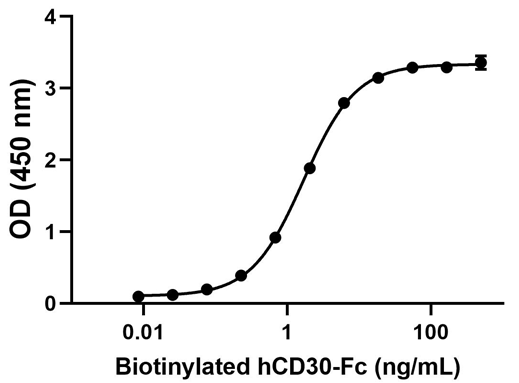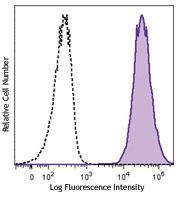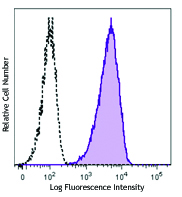- Regulatory Status
- RUO
- Other Names
- B cell maturation antigen (BCMA), tumor necrosis factor receptor superfamily member 17, CD269.
- Ave. Rating
- Submit a Review
- Product Citations
- publications

-

Human TNFRSF17 inhibits the B cell proliferation induced by mouse TNFSF13 (APRIL). -

Stability testing for human TNFRSF17. Human TNFRSF17 was aliquoted in PBS, pH7 at 0.2 mg/ml and one aliquot was kept at 4°C (control), and another was freeze/thawed four times (4x freeze/thaws). After this procedure, the samples were tested for their ability to inhibit the proliferation of human B cells induced by TNFSF13 (APRIL).
Human TNFRSF17 is a type I attached membrane protein of 184 amino acids, possesses a conserved motif of six cysteines in the N-terminal, consistent with the formation of a cysteine repeat motif found in the extracellular domain of TNFRs. Overexpression of TNFRSF17 in 293 cells activates NF-kappa B, Elk-1, the c-Jun N-terminal kinase, and the p38 mitogen-activated protein kinase, after its association with TNF Receptor-Associated Factor (TRAF) 1, TRAF2, and TRAF3. Soluble forms of TACI (TNFRSF13B) and TNFRSF17 bind to BAFF (TNFSFL13B) and APRIL (TNFSFL13A); the interaction of TNFRSF17 to APRIL has higher affinity than the TNFRSF17-BAFF interaction. Analysis of BCMA knockout mice (BCMA−/−) showed no differences in the steady-state frequencies or composition of peripheral B cell subsets (immature, marginal zone, follicular, B1). TNFRSF17 expression is upregulated on PBMCs from mice that develop a Sjogren’s-like syndrome, patients with Sjogren’s syndrome, with rheumatoid arthritis, and on B cells from SLE patients. Patients with multiple myeloma show elevated serum BCMA levels and it correlated with the proportion of plasma cells in bone marrow biopsies and clinical status. Serum BCMA levels in considered a novel biomarker to predict outcomes for multiple myeloma patients.
Product DetailsProduct Details
- Source
- Human TNFRSF17, amino acids (Met1 – Ala54) (Accession # NP_001183) was expressed in 293E cells. Human IgG-Fc is in the carboxyl-terminus.
- Molecular Mass
- The 293 amino acid recombinant protein has a predicted molecular mass of approximately 32.7 kD. The DTT-reduced and non-reduced protein migrate at approximately 40-45 kD and 80-85 kD respectively by SDS-PAGE. The predicted N-terminal amino acid is Met.
- Purity
- > 95% by SDS-PAGE gel as determined by Coomassie stained SDS-PAGE.
- Formulation
- 0.22 µm filtered protein solution is in PBS pH 7.2.
- Endotoxin Level
- Less than 0.10 EU per µg of protein as determined by the LAL method.
- Concentration
- 10 and 25 µg sizes are bottled at 200 µg/mL. 100 µg size and larger sizes are lot-specific and bottled at the concentration indicated on the vial. To obtain lot-specific concentration and expiration, please enter the lot number in our Certificate of Analysis online tool.
- Storage & Handling
- Unopened vial can be stored between 2°C and 8°C for up to 2 weeks, at -20°C for up to six months, or at -70°C or colder until the expiration date. For maximum results, quick spin vial prior to opening. The protein can be aliquoted and stored at -20°C or colder. Stock solutions can also be prepared at 50 - 100 µg/mL in appropriate sterile buffer, carrier protein such as 0.2 - 1% BSA or HSA can be added when preparing the stock solution. Aliquots can be stored between 2°C and 8°C for up to one week and stored at -20°C or colder for up to 3 months. Avoid repeated freeze/thaw cycles.
- Activity
- Human TNFRSF17 inhibits the B cell proliferation (measured with Deep Blue Cell Viability™ Kit, Cat. No. 424701) induced by mouse TNF SF13 (APRIL) in a dose dependent manner. The ED50= 8 - 40 ng/ml.
- Application
-
Bioassay
- Application Notes
-
BioLegend carrier-free recombinant proteins provided in liquid format are shipped on blue-ice. Our comparison testing data indicates that when handled and stored as recommended, the liquid format has equal or better stability and shelf-life compared to commercially available lyophilized proteins after reconstitution. Our liquid proteins are verified in-house to maintain activity after shipping on blue ice and are backed by our 100% satisfaction guarantee. If you have any concerns, contact us at tech@biolegend.com.
Antigen Details
- Structure
- Homodimer
- Distribution
-
Resting and activated B cells, malignant B lymphocytes, plasma cells.
- Function
- Maintains the peripheral B cell population and survival of long-lived bone marrow plasma cells. Soluble BCMA acts as a decoy receptor for APRIL. TNFRSF17 mRNA is stimulated by IL-4 and IL-6 in murine B cells.
- Interaction
- Monocytes, macrophages, T cells, and dendritic cells.
- Ligand/Receptor
- TNFSF13 (APRIL), TNFSF (BAFF)
- Bioactivity
- Inhibits the B cell proliferation induced by mouse TNFSF13 (APRIL) .
- Biology Area
- Immunology
- Molecular Family
- Soluble Receptors
- Antigen References
-
- Madry C, et al. 1998. Int Immunol. 10:1693.
- Hatzoglou A, et al. 2000. J Immunol. 165:1322.
- Rennert P, et al. 2000. J Exp Med. 192:1677.
- Wallweber HJ, et al. 2004. J Mol Biol. 2004 343:283.
- O'Connor BP, et al. 2004. J Exp Med. 199:91.
- Kim J, et al. 2011. Autoimmunity. 44:69.
- Coqueri CM, and Erickson LD. 2012. Crit Rev Immunol. 32:287.
- Laurent SA, et al. 2015. Nature Commun. 6:7333.
- Ghermezi M, et al. 2017. Hematologica. 102:785.
- Gene ID
- 608 View all products for this Gene ID
- UniProt
- View information about TNFRSF17 on UniProt.org
Related Pages & Pathways
Pages
Related FAQs
- Why choose BioLegend recombinant proteins?
-
• Each lot of product is quality-tested for bioactivity as indicated on the data sheet.
• Greater than 95% Purity or higher, tested on every lot of product.
• 100% Satisfaction Guarantee for quality performance, stability, and consistency.
• Ready-to-use liquid format saves time and reduces challenges associated with reconstitution.
• Bulk and customization available. Contact us.
• Learn more about our Recombinant Proteins. - How does the activity of your recombinant proteins compare to competitors?
-
We quality control each and every lot of recombinant protein. Not only do we check its bioactivity, but we also compare it against other commercially available recombinant proteins. We make sure each recombinant protein’s activity is at least as good as or better than the competition’s. In order to provide you with the best possible product, we ensure that our testing process is rigorous and thorough. If you’re curious and eager to make the switch to BioLegend recombinants, contact your sales representative today!
- What is the specific activity or ED50 of my recombinant protein?
-
The specific activity range of the protein is indicated on the product datasheets. Because the exact activity values on a per unit basis can largely fluctuate depending on a number of factors, including the nature of the assay, cell density, age of cells/passage number, culture media used, and end user technique, the specific activity is best defined as a range and we guarantee the specific activity of all our lots will be within the range indicated on the datasheet. Please note this only applies to recombinants labeled for use in bioassays. ELISA standard recombinant proteins are not recommended for bioassay usage as they are not tested for these applications.
- Have your recombinants been tested for stability?
-
Our testing shows that the recombinant proteins are able to withstand room temperature for a week without losing activity. In addition the recombinant proteins were also found to withstand four cycles of freeze and thaw without losing activity.
- Does specific activity of a recombinant protein vary between lots?
-
Specific activity will vary for each lot and for the type of experiment that is done to validate it, but all passed lots will have activity within the established ED50 range for the product and we guarantee that our products will have lot-to-lot consistency. Please conduct an experiment-specific validation to find the optimal ED50 for your system.
- How do you convert activity as an ED50 in ng/ml to a specific activity in Units/mg?
-
Use formula Specific activity (Units/mg) = 10^6/ ED50 (ng/mL)
 Login / Register
Login / Register 












Follow Us